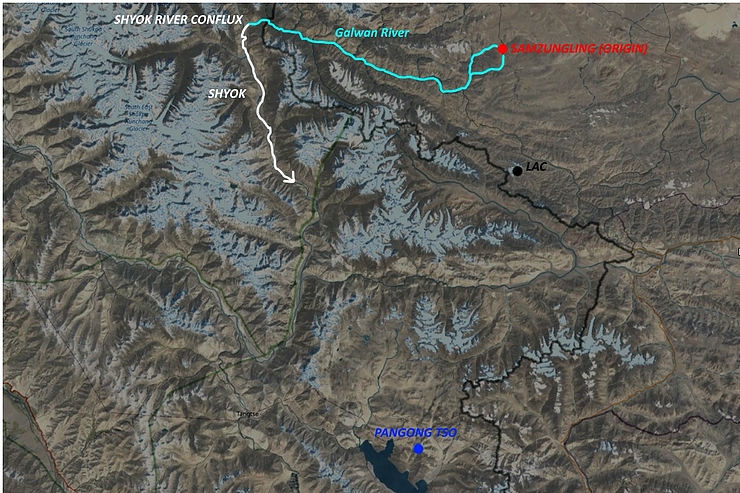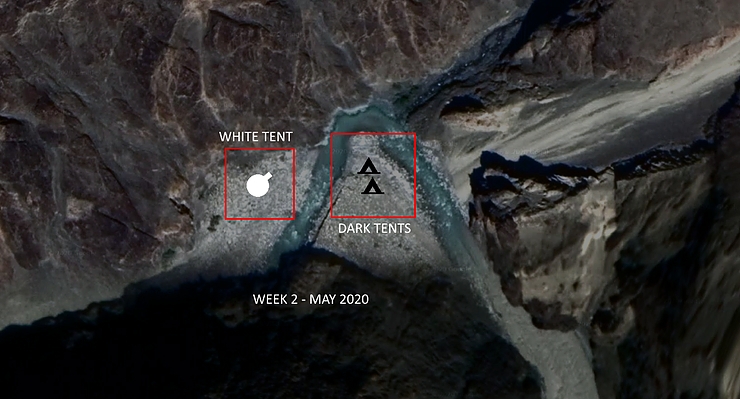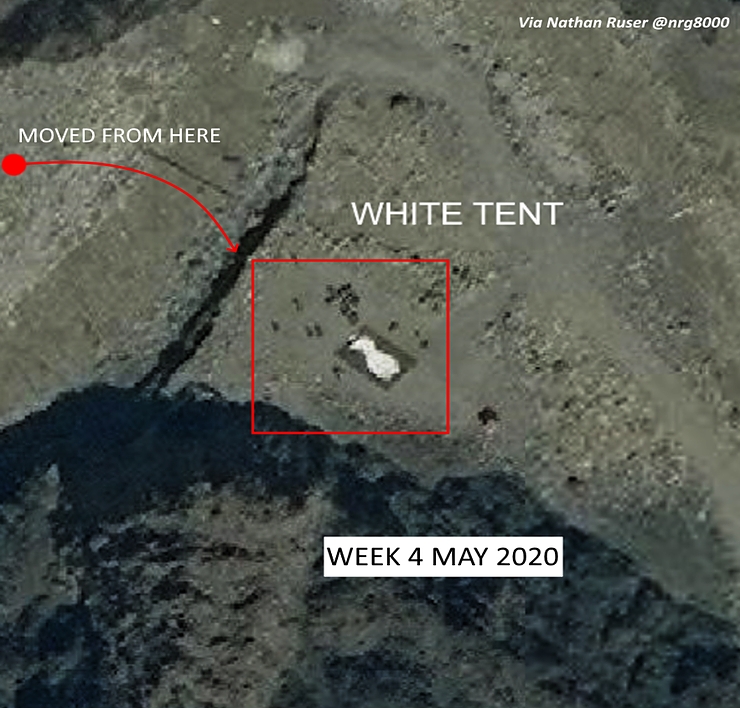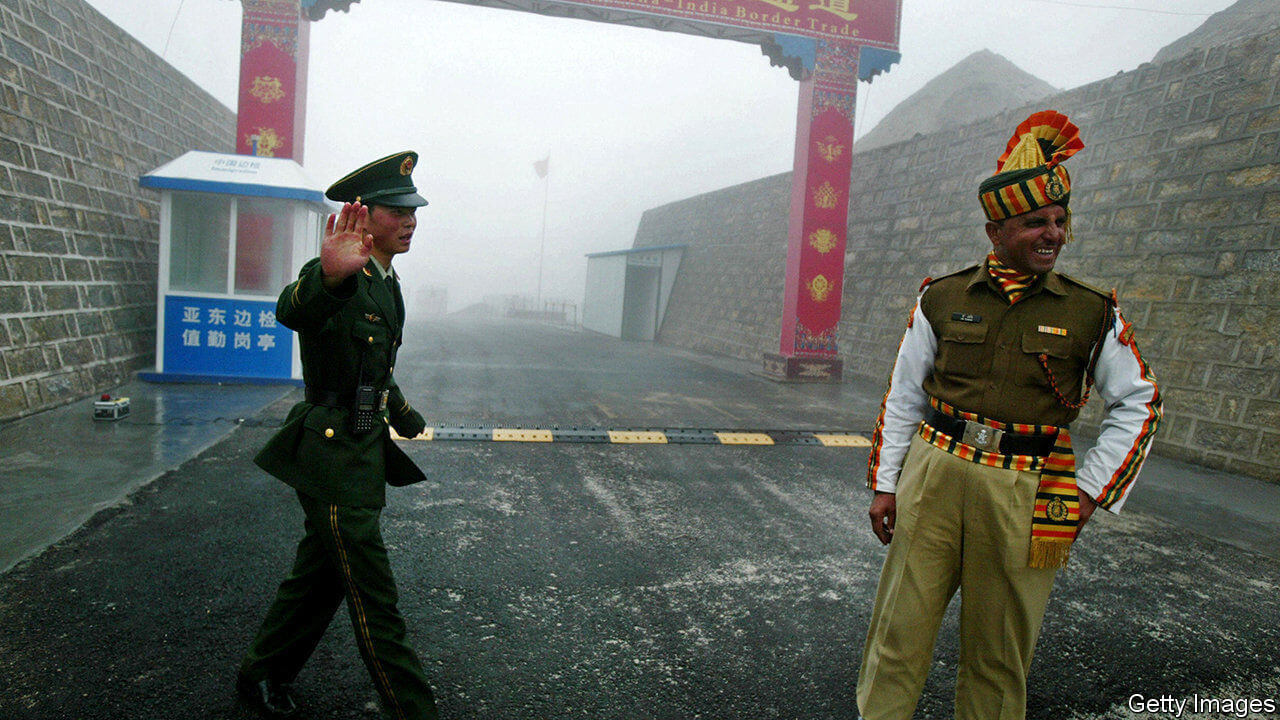In the recent clash between India and China, Galwan Valley in Eastern Ladakh became a flashpoint. In the weeks leading to the deadly conflict between the two countries on the night of June 15th, China blocked the flow of the Galwan river into Indian territory. While experts have discussed at great length the military tactics and psy-ops used by the two nuclear neighbours, China’s blockade of the Galwan river as tensions were simmering at the border has received little attention. 
The Galwan river, which originates in the Samzungling area of Chinese-controlled Aksai Chin, flows to the Galwan region in India’s side of the Line of Actual Control (LAC) before merging with the Shyok river—an upper tributary of the river Indus. Satellite images taken in the second and third week of May show a full- flowing river, while subsequent images taken in the fourth week of May show the exposed riverbed of the Galwan river as a result of a blockade in Chinese territory. While India and China do not have a treaty on the shared use of the Galwan’s waters, China’s actions of unilaterally stopping the flow of the river amount to a violation of the customary rules of international law on the use of shared water resources.


Multiple international treaties including the Convention on the Law of the Non-Navigational Uses of International Watercourses (1997), the Stockholm Declaration on the Human Environment (1971), the Helsinki Rules on the Uses of the Waters of International Rivers (1966), and the Rio Declaration on Environment and Development (1992), have codified the use of shared water resources. These treaties highlight the concept of “equitable and reasonable” use of shared water resources. It has been argued that such equitable use of the water resource results in the “restricted sovereignty” of riparian states. Thus, while a state may claim to have an absolute right over the use of the river in its territory, such use is “restricted” by the rights of the lower riparian state. A riparian state, therefore, cannot take unilateral action with regard to a shared watercourse. This concept is closely associated with the obligation of states to not cause significant transboundary harm or the “no-harm obligation”—a principle of customary international law—which is “identified with the Latin maxim sic utere tuo ut alienum non laedas (so use your own as not to harm that of another)”. The concept of “restricted sovereignty” and the “no-harm obligation” are recognized as customary rules of international law, thus binding all countries even in the absence of an express treaty commitment towards the same.
In international disputes on shared water resources, the Permanent Court of International Justice (PCIJ) and the International Court of Justice (ICJ) have also recognized the equal rights enjoyed by riparian states on the basis of a “community of interest”. As decided by the PCIJ in the River Oder case (1929), this community of interest is the basis of a common legal right, “the essential features of which are the perfect equality of all riparian States in the user of the whole course of the river and the exclusion of any preferential privilege of any one riparian State in relation to the others.” This was reiterated by the ICJ in the Gabcikovo-Nagymaros case between Hungary and Slovakia in 1997. The two cases and the evolution of the concept of community of interest in international law highlight the shared interests and equal rights enjoyed by riparian states with regard to a trans-boundary waterbody. China’s action of unilaterally blocking the flow of the Galwan river and cutting off water supply from India, therefore, flout customary rules of international law by infringing upon India’s rights as a lower riparian state.
In addition to the blockade, there have also been reports of China constructing a dam on the river, which could result in long-term damage to the ecosystem of the river and adversely affect its flow into Indian territory. Such unilateral action by China and the weaponization of its upper riparian status is, however, not novel. In the past China has violated its international obligations by refusing to cooperate with India on trans-boundary river management. After the 73-day Doklam standoff between India and China in 2017, there were speculations that the latter withheld hydrological data—in contravention of an agreement between India and China—for the Brahmaputra and Sutlej rivers resulting in floods in Assam and Uttar Pradesh. China has also weaponized its status as the upper riparian state and caused significant harm to lower riparian states like Vietnam, Cambodia, Laos, and Thailand by exacerbating the current drought—the “worst in living memory”—faced by these countries.
The Tibetan region—which is in China’s control—has been called the “Third Pole” owing to its vast reserves of freshwater. Seven of the mightiest rivers in South Asia including the Indus, Ganges, Brahmaputra, Irrawaddy, Salween, Yangtze, and Mekong originate in in this region. China has expressly claimed ownership over Tibet's waters, thus making it an “upstream controller” of the third largest freshwater reserve on which 46% of the world’s population depends. This gives China a chokehold on South Asia’s economy—making it more important to check China’s unilateral actions and tendency to weaponize its status as the upper riparian state at each stage.
This article was originally published on New World Order.

